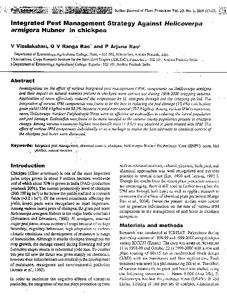Integrated pest management strategy against Helicoverpa armigera Hubner in chickpea
Abstract
Investigations on the effect of various integrated pest management (IPM) components on Helicoverpa armigera and their impact on natural enemies present in chickpea were carried out during 1998-2000 cropping seasons in Patancheru, Andhra Pradesh, India. Application of neem effectively reduced the oviposition by H. armigera throughout the cropping period. The integration of various IPM components was found to be the best in reducing the pod damage (10.4%) with highest grain yield (1264.4 kg/ha) with 58.5% increase in yield over control (797.9 kg/ha). Among various IPM components, neem and Helicoverpa Nuclear Polyhedrosis Virus were as effective as endosulfan in reducing the larval population and pod damage. Endosulfan was found to be more harmful to the natural enemy population present in chickpea canopy. The highest cost-benefit ratio (1:3.01) was obtained in plots treated with IPM. The effect of various IPM components individually or as a package to develop the best alternative to chemical control of the chickpea pod borer are discussed

